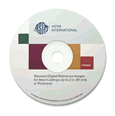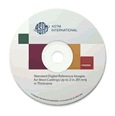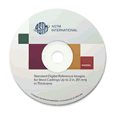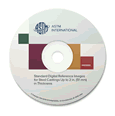Potrebujeme váš súhlas na využitie jednotlivých dát, aby sa vám okrem iného mohli ukazovať informácie týkajúce sa vašich záujmov. Súhlas udelíte kliknutím na tlačidlo „OK“.
ASTM E2868-22
Standard Digital Reference Images for Steel Castings up to 2 in. (50.8 mm) in Thickness
NORMA vydaná dňa 1.12.2022
Informácie o norme:
Označenie normy: ASTM E2868-22
Dátum vydania normy: 1.12.2022
Kód tovaru: NS-1098674
Počet strán: 6
Približná hmotnosť: 18 g (0.04 libier)
Krajina: Americká technická norma
Kategória: Technické normy ASTM
Kategórie - podobné normy:
Anotácia textu normy ASTM E2868-22 :
Keywords:
digital reference images, discontinuities, discontinuity classification criterion, gamma ray, X-ray,, ICS Number Code 77.040.20 (Non-destructive testing of metals),77.140.80 (Iron and steel castings)
K tejto norme patria tieto doplnky:
Reference Radiograph for E2868 Steel Castings Up to 2 in. (50.8 mm) in Thickness; Volume I + Active Standard
Vybraný formát:Zobraziť všetky technické informácie
Reference Radiograph for E2868 Steel Castings Up to 2 in. (50.8 mm) in Thickness; Volume II + Active Standard
Vybraný formát:Zobraziť všetky technické informácie
Reference Radiograph for E2868 Steel Castings Up to 2 in. (50.8 mm) in Thickness; Volume III + Active Standard
Vybraný formát:Zobraziť všetky technické informácie
Reference Radiograph for E2868 Steel Castings Up to 2 in. (50.8 mm) in Thickness; Volumes I, II, & III + Active Standard
Vybraný formát:Zobraziť všetky technické informácie
Doplňujúce informácie
| Significance and Use | ||||||||||||||||
|
4.1?Personnel utilizing reference radiographs to this standard shall be qualified to perform radiographic interpretation in accordance with a nationally or internationally recognized NDT personnel qualification practice or standard and certified by the employer or certifying agency, as applicable. The practice or standard used and its applicable revision shall be identified in the contractual agreement between the using parties. If assistance is needed with interpreting specifications and product requirements as applied to the reference radiographs, a certified Level III shall be consulted before accept/reject decisions are made (if the Level III is the radiographic interpreter, this may be the same person). 4.2?Graded reference images are intended to provide a guide enabling recognition of specific casting discontinuity types and relative severity levels that may be encountered during typical fabrication processes. Reference images containing ungraded discontinuities are provided as a guide for recognition of a specific casting discontinuity type where severity levels are not needed. These reference images are intended as a basis from which manufacturers and purchasers may, by mutual agreement, select particular discontinuity classes to serve as standards representing minimum levels of acceptability (see Sections 6 and 7). 4.3?Reference images represented by this standard may be used, as agreed upon in a purchaser supplier agreement, for energy levels, thicknesses, or both outside the range of this standard when determined applicable for the casting service application. 4.4?Procedures for evaluation of production images using applicable reference images of this standard are prescribed in Section 8; however, there may be manufacturing-purchaser issues involving specific casting service applications where it may be appropriate to modify or alter such requirements. Where such modifications may be appropriate for the casting application, all such changes shall be specifically called-out in the purchaser supplier agreement or contractual document. Section 9 addresses purchaser supplier requisites for where weld repairs may be required. 4.5?Agreement should be reached between cognizant engineering organization and the supplier that the system used by the supplier is capable of detecting and classifying the required discontinuities. |
||||||||||||||||
| 1. Scope | ||||||||||||||||
|
1.1?These digital reference images illustrate various categories, types, and severity levels of discontinuities occurring in steel castings that have section thicknesses up to 2 in. (50.8 mm). The digital reference images are an adjunct to this standard and must be purchased separately from ASTM International, if needed (see 2.3). Categories and severity levels for each discontinuity type represented by these digital reference images are described in 1.2. Note 1:?The basis of application for these reference images
requires a prior purchaser supplier agreement of radiographic
examination attributes and acceptance criteria as described in
Sections 4, 6, and 7 of this standard.
1.2?These digital reference images consist of three separate volumes (see Note 2) as follows: (I) medium voltage (nominal 250-kV) X-rays, (II) 1-MV X-rays and Iridium-192 radiation, and (III) 2-MV to 4-MV X-rays and Cobalt-60 radiation. Unless otherwise specified in a purchaser supplier agreement (see 1.1), each volume is for comparison only with production digital images produced with radiation energy levels within the thickness range covered by this standard. Each volume consists of six categories of graded discontinuities of increasing severity level and four categories of ungraded discontinuities. Reference images containing ungraded discontinuities are provided as a guide for recognition of a specific casting discontinuity type where severity levels are not needed. The following is a list of discontinuity categories, types, and severity levels for the adjunct digital reference images of this standard: 1.2.1?Category A Gas porosity; severity levels 1 through 5. 1.2.2?Category B Sand and slag inclusions; severity levels 1 through 5. 1.2.3?Category C Shrinkage; 4 types: 1.2.3.1?Calinear shrinkage Severity levels 1 through 5. 1.2.3.2?Cbfeathery shrinkage Severity levels 1 through 5. 1.2.3.3?Ccsponge shrinkage Severity levels 1 through 5. 1.2.3.4?Cdcombinations of linear, feathery, and sponge shrinkage Severity levels 1 through 5. 1.2.4?Category DCrack; 1 illustration. 1.2.5?Category EHot Tear; 1 illustration. 1.2.6?Category FInsert; 1 illustration. 1.2.7?Category GMottling; 1 illustration. (See Note 3.) Note 2:?The digital reference images consist of the
following:
Note 3:?Although Category G Mottling is listed for all three volumes, the appearance of mottling is dependent on the level of radiation energy. Mottling appears reasonably prominent in Volume I; however, because of the higher radiation energy levels mottling may not be apparent in Volume II nor Volume III. 1.3?All areas of this standard may be open to agreement between the cognizant engineering organization and the supplier, or specific direction from the cognizant engineering organization. These items should be addressed in the purchase order or the contract. 1.4?These digital reference images are not intended to illustrate the types and degrees of discontinuities found in steel castings up to 2 in. (50.8 mm) in thickness when performing film radiography. If performing film radiography of steel castings up to 2 in. (50.8 mm) in thickness, refer to Reference Radiographs E446. 1.5?Only licensed copies of the software and images shall be utilized for production inspection. A copy of the ASTM/User license agreement shall be kept on file for audit purposes. (See Note 4.) Note 4:?Each volume of digital reference images consists of 7
digital data files, software to load the desired format and
specific instructions on the loading process. The 34 reference
images in each volume illustrate six categories of graded
discontinuities and four categories of ungraded discontinuities and
contain an image of a step wedge. Available from ASTM International
Headquarters, Order No: RRE286801 for Volume I, RRE286802 for
Volume II, and RRE286803 for Volume III.
1.6?UnitsThe values stated in inch-pound units are to be regarded as standard. The values given in parentheses are mathematical conversions to SI units that are provided for information only and are not considered standard. 1.7?This standard does not purport to address all of the safety concerns, if any, associated with its use. It is the responsibility of the user of this standard to establish appropriate safety, health, and environmental practices and determine the applicability of regulatory limitations prior to use. 1.8?This international standard was developed in accordance with internationally recognized principles on standardization established in the Decision on Principles for the Development of International Standards, Guides and Recommendations issued by the World Trade Organization Technical Barriers to Trade (TBT) Committee. |
||||||||||||||||
| 2. Referenced Documents | ||||||||||||||||
|








 Cookies
Cookies
